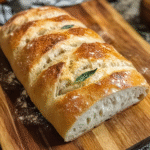1️⃣ Introduction to Crusty Italian Bread
There’s something truly magical about crusty Italian bread. With its golden-brown, crackly crust and soft, airy crumb, this rustic loaf embodies the heart of Italian baking traditions. Baked with simple, wholesome ingredients—flour, water, yeast, and salt—it’s the perfect companion to soups, stews, or even a simple drizzle of olive oil.
Home bakers everywhere are drawn to its no-knead simplicity, making it an accessible choice for both seasoned bakers and beginners alike. The process of creating this bread—allowing the dough to rise slowly, shaping it carefully, and baking it on a pizza stone or in a dutch oven—unlocks a depth of flavor and texture that store-bought loaves can’t match.
Whether you’re serving it as a side, making bruschetta, or tearing off a piece to enjoy with butter, crusty Italian bread invites you to savor each bite—and share it with those you love. 🍞✨
Why We Love Crusty Italian Bread
- Crackling crust that satisfies every bite.
- Soft, fluffy crumb perfect for sandwiches and dipping.
- An essential companion to hearty meals like Chicken Spaghetti.
2️⃣ A Brief History of Crusty Italian Bread
The story of crusty Italian bread is deeply woven into Italy’s culinary tapestry. For centuries, Italian bakers have crafted loaves using traditional techniques passed down through generations. In medieval times, bread ovens were the heart of many villages, where families would gather to bake their weekly loaves.
The hallmark of rustic Italian bread—its crackly crust—emerged from wood-fired ovens that created intense heat and natural steam, essential for developing that signature crunch. Regions like Tuscany and Puglia became renowned for their variations, from saltless loaves to olive-infused recipes.
As Italy modernized, so did its bread-making methods. Today, home bakers replicate that crusty perfection using pizza stones and dutch ovens to mimic the environment of traditional ovens. More than just a staple, crusty Italian bread reflects Italy’s passion for simple, high-quality ingredients and the art of sharing good food with family and friends. 🍞🇮🇹
3️⃣ Essential Ingredients and Their Roles
The magic of crusty Italian bread lies in its simplicity and the way each ingredient contributes to its signature crackly crust and soft, airy crumb. Let’s explore the essential components that make this rustic loaf a timeless favorite.
- Flour: The backbone of any bread, all-purpose or bread flour (with higher protein content) provides the structure needed to support the dough’s expansion during baking, giving it that open crumb.
- Water: Hydration is crucial for activating the yeast and developing gluten. Warm water encourages yeast activity, leading to a lighter, airier loaf.
- Yeast: Instant dry yeast or active dry yeast ensures a consistent rise. This ingredient is responsible for the bread’s lift and airy texture.
- Salt: Enhances flavor and helps regulate yeast fermentation. It’s essential for achieving a balanced taste.
- Optional Add-Ins: For creative twists, consider adding:
- Chopped rosemary or thyme for an herbal note.
- Black olives for a Mediterranean touch.
- Sesame or poppy seeds sprinkled on top for added crunch.
When these ingredients come together, they create a loaf that’s both simple and stunning, perfect for any meal. 🍞✨
Pair this bread with spreads like Cilantro Garlic Sauce for a unique twist.
4️⃣ Step-by-Step Recipe for Crusty Italian Bread
Baking crusty Italian bread at home is easier than you might think. Here’s a straightforward recipe that captures the essence of artisan Italian bread, complete with a crackly crust and a soft, airy interior.
Ingredients:
- 3 ¼ cups all-purpose flour (plus extra for dusting)
- 1 tsp sea salt
- 1.5 cups warm water
- 2 tsp instant yeast (or active dry yeast)
Instructions:
- Mix the Dough
- In a large mixing bowl, combine flour, salt, and yeast.
- Pour in the warm water and stir with a spatula or wooden spoon until a sticky dough forms.
- First Rise
- Cover the bowl loosely with plastic wrap or a damp kitchen towel.
- Let it rise at room temperature for 2 to 3 hours until doubled in size.
- Shape the Loaf
- Lightly flour your work surface and gently turn the dough out onto it.
- With floured hands, shape the dough into a rough round or oval, being careful not to deflate it.
- Score the top with a sharp knife to help with oven spring.
- Preheat the Oven
- Place a pizza stone or dutch oven inside and preheat to 450°F for 45 minutes.
- Add a small oven-safe bowl of water on the bottom rack to create steam for a crackly crust.
- Bake the Bread
- Carefully transfer the dough to the hot stone or into the dutch oven.
- Bake for 30–45 minutes until golden brown and crusty.
- Cool on a wire rack before slicing.
Enjoy this rustic masterpiece warm with olive oil or as the base for a delicious bruschetta! 🍞
Serve this bread with meals like Baked Salmon Meatballs with Avocado Sauce for a balanced and satisfying plate.

5️⃣ The Science Behind a Crusty Crust
Achieving the perfect crusty crust is a blend of science and art. When baking crusty Italian bread, the key factor is steam. During the initial phase of baking, steam keeps the dough’s surface moist, allowing it to expand fully without setting prematurely. This results in that classic open crumb structure with its airy holes.
As the bake progresses, the steam evaporates, and the oven’s dry heat kicks in, forming a hard, crackly crust that’s both flavorful and satisfying to the bite.
Using a pizza stone or dutch oven helps replicate the conditions of traditional wood-fired ovens by retaining heat and promoting even cooking. A bowl of water on the bottom rack (or trapping steam inside the dutch oven) enhances this effect.
This combination of hydration, heat, and steam transforms simple ingredients into a rustic masterpiece—one that’s a feast for the senses and a testament to the magic of home baking. 🍞🔥
6️⃣ Variations and Creative Twists
While the classic crusty Italian bread is delicious on its own, you can easily elevate its flavor with a few creative twists. For a Mediterranean flair, fold in chopped rosemary and black olives to the dough. Sprinkle sesame or poppy seeds on top before baking for added crunch and visual appeal. If you’re feeling adventurous, incorporate sun-dried tomatoes or roasted garlic for a robust, savory punch. You can even shape the dough into smaller rolls perfect for sliders or appetizers. These customizable variations keep the bread exciting and adaptable to any meal, adding a personal touch to every bite. 🍞✨
7️⃣ How to Serve and Enjoy Crusty Italian Bread
Serving crusty Italian bread is all about highlighting its rustic charm and crackly crust. Start by tearing off a warm piece and enjoying it with a simple spread of butter or dipping it into a dish of extra virgin olive oil, seasoned with red chili flakes and fresh herbs for an authentic Mediterranean experience.
Pair this artisan loaf with hearty dishes like soups, stews, and pasta. It’s perfect for soaking up the flavors of meals like Chicken Spaghetti or a rich tomato-based stew.
For a lighter touch, transform it into the ultimate bruschetta by toasting slices and topping them with fresh tomatoes, basil, and a drizzle of olive oil.
This bread also makes an excellent base for sandwiches or panini, supporting a variety of fillings while retaining its signature crunch. No matter how you serve it, crusty Italian bread elevates every meal into a feast for the senses. 🍞
8️⃣ Storage and Shelf Life
Proper storage is key to maintaining the crusty texture and freshness of your Italian bread. After baking, allow the loaf to cool completely on a wire rack. This helps prevent moisture from getting trapped inside the crust, which can lead to sogginess.
For short-term storage, keep the bread at room temperature in a paper bag or a bread box. This allows air circulation while preserving the crackly crust. Avoid storing it in plastic bags, as they trap humidity and soften the crust.
Crusty Italian bread typically stays fresh for 1–2 days at room temperature. If it begins to dry out, revive it by lightly misting it with water and warming it in the oven for 5–10 minutes.
While freezing is an option, it’s best to enjoy this bread fresh. However, you can slice and wrap it tightly in foil and plastic wrap for longer storage—perfect for quick reheating in the oven when needed. 🍞 Refresh stale bread by toasting or using in recipes like Oven Roasted Garlic Cabbage Steaks.
9️⃣ Troubleshooting Common Baking Issues
- Bread didn’t rise: Check your yeast and water temperature.
- Dense crumb: Avoid overmixing or adding too much flour.
- Sticky dough: Flour your hands, but resist overworking it.
🔟 Nutritional Profile
- About 195 kcal per slice.
- 40g carbohydrates, 2g fiber, 6g protein.
- Minimal fat, perfect for balanced meals.

crusty Italian bread
- Total Time: 50 minutes
- Yield: 1 medium loaf
Description
A rustic Italian bread with a crackly crust and soft, airy crumb. Perfect for dipping, sandwiches, or enjoying on its own.
Ingredients
- – 3 ¼ cups all-purpose flour (plus extra for dusting)
- – 1 tsp sea salt
- – 1.5 cups warm water
- – 2 tsp instant yeast (or active dry yeast)
Instructions
- 1️⃣ In a large bowl, combine flour, salt, and yeast.
- 2️⃣ Pour in warm water and mix until a sticky dough forms.
- 3️⃣ Cover loosely and let rise at room temperature for 2–3 hours.
- 4️⃣ Shape gently into a round loaf and score the top.
- 5️⃣ Preheat oven to 450°F with a pizza stone and a bowl of water for steam.
- 6️⃣ Bake for 30–45 minutes until golden brown.
- 7️⃣ Cool completely before slicing.
Notes
– For added flavor, incorporate herbs like rosemary or olives.
– Let the loaf cool on a wire rack to keep the crusty texture.
- Prep Time: 10 minutes
- Cook Time: 40 minutes
- Category: Bread
- Cuisine: Italian
Nutrition
- Calories: 195
1️⃣1️⃣ Cultural Significance
From Tuscan saltless loaves to crusty ciabatta, bread is a symbol of community and tradition across Italy. A loaf of crusty Italian bread is more than a meal—it’s a connection to family and history.
1️⃣2️⃣ FAQs
What makes Italian bread crusty?
Steam in the oven creates a crisp crust while the interior stays soft.
How do you keep it crusty?
Cool on a rack; store in paper bags, not plastic.
Can you freeze it?
Yes—wrap in foil and freeze; reheat in the oven.
What’s the difference between Italian and French bread?
Italian bread tends to have a thicker crust and denser crumb.
Is crusty bread healthy?
Yes—made with simple ingredients and lower in fat.
Conclusion
With these tips, you’ll create a rustic loaf that’s as beautiful as it is delicious. Experiment with different toppings, fillings, and serving styles. Serve it with meals like Sweet Onion Sauce or alongside Hawaiian Cream Cheese Rolls for a feast that’s both comforting and memorable.



